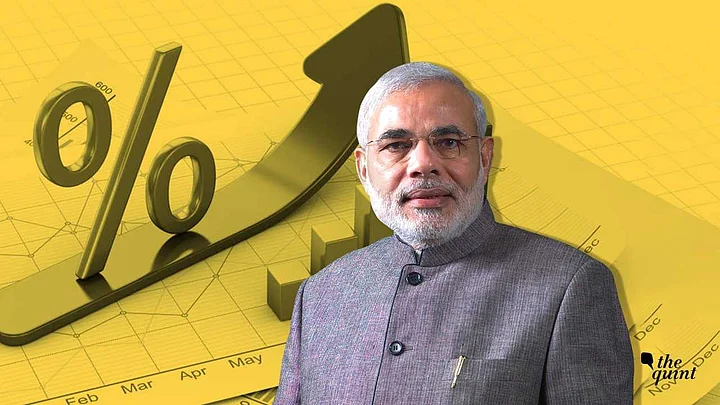What was the rationale given by the government while keeping the retail price of petrol-diesel high, despite falling crude prices in the international market?
Union petroleum minister is reported to have said that since the previous UPA government had left a debt burden of Rs 2 lakh crore on the oil sector (Rs 70,000 crore of which was interest component, according to him), there was very little that could be done to give relief to the consumers.
He had basically blamed the previous regime for resorting to, what is known as, a system of payment deferral, leaving additional debt burden for future governments. Such deferral comes with a cost in the form of huge interest outgo.
The minister wanted to give the impression that his government is intent on clearing past dues so that interest burden is substantially reduced.
Has his government walked the talk?
A recently released report of the Comptroller and Auditor General of India (CAG), however, shows that the present regime has taken the system of payment deferral to a new level altogether. And interest burden therefore has gone up considerably.
Let us recall that UPA government had issued oil bonds worth Rs 1.44 lakh crore between 2005 and 2010.
The bonds were issued to compensate oil marketing companies for the losses incurred as they were made to sell petrol-diesel below the cost incurred.
The idea was to cushion the customers from unprecedented price escalation then while ensuring that payment for the same is made in a staggered manner, mostly over a period of 15 to 20 years, without burdening the exchequer in one go.
Oil bonds were off-budget items, not included in the annual financial statement and therefore did not impact the fiscal numbers then.
According to a Moneycontrol.com report, “only two bonds worth Rs 1,750 crore each matured during the tenure of the NDA government. This implies that the government has only repaid Rs 3,500 crore. The next payment will be due in October 2021.”
The report shows that the minister’s claim of clearing all dues is just an eyewash. On the contrary, his government has a fair share of off-budget items.
The CAG report says the “government has adopted off-budget means of financing the subsidy arrears, thereby deferring the payment in the relevant financial year and in the process also incurring additional cost by way of interest payments.”
The Modi government clearly has not walked the talk. What is worse, while the subsidy amount has stayed more or less the same all through, the carryover liability has ballooned in the last four years.
Let us take the case of fertiliser subsidy. While the quantum of fertiliser subsidy has stayed in the region of Rs 70,000 crore, the carryover liability has surprisingly increased from nearly Rs 26,000 crore in 2012-13 to Rs 39,000 crore in 2016-17, an increase of nearly 50 percent in just four years.
“To overcome the liquidity problems of the fertilizer companies, Department makes ‘Special Banking Arrangement’ (SBA) in which loans from PSU banks are arranged to make payments against arrears of subsidies with some selected companies. Government makes payments of interest on these loans at Government Security (G-sec) rate. Interest over and above G-sec rate is borne by the fertilizer companies.”
What it means is that the system of payment deferral like this not only increases government’s interest burden, it also adversely impacts the health of fertiliser companies and banks.
Payment Deferral of Amount More Than Total Food Subsidy
It has been far worse in the case of handling of food subsidy. Following the government’s mandate, the Food Corporation of India (FCI) procures food grains at minimum support price and offers the same to fair price shops as part of the Public Distribution System (PDS).
The difference in the cost of procurement and the cost of supplying to fair price shops forms the subsidy burden to be borne by the government.
As against the subsidy burden of nearly Rs 72,000 in 2012-13, the then government had deferred payment of Rs 32,000 crore. However, in 2016-17, the carryover liability was to the tune of Rs 81,000 crore as against the total subsidy burden of Rs 78,000 crore.
The CAG report says: “In terms of revenue spending, off-budget financing was used for covering deferring fertilizer arrears/bills through special banking arrangements; food subsidy bills/arrears of FCI through borrowings and for implementation of irrigation scheme (AIBP) through borrowings by NABARD under the Long Term Irrigation Fund (LTIF). In terms of capital expenditure, off budget financing of railway projects through borrowings of the IRFC and financing of power projects through the PFC are outside the budgetary control.”
Should we then believe the government’s fiscal numbers?
We Pay More Interest Now Than What We Paid 5 Years Ago
“It is evident that there was increase of about 350 percent in carried over subsidy arrears in the five years preceding 2016-17 which require financing from a number of methods including very high interest cash credit facility which increases actual cost of this subsidy substantially.”The CAG report
The CAG report concludes that “such off-budget financial arrangement, defers committed liability, being interest bearing, increases cost of subsidy, and understates the annual subsidy expenditure and prevents transparent depiction of fiscal indicators for the relevant year.”
The conclusion flies in the face of the government’s stated claim of insulating future generations from higher interest burden. The current regime has done just the contrary by pushing off-budget items beyond any reasonable level.
Interest payment, therefore, as part of total revenue expenditure, has gone up from 23.2 percent in 2012-13 to 26.1 percent in 2016-17.
